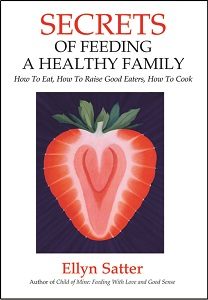

Family Meals Focus
The Ellyn Satter Institute Newsletter
Eating competence: Putting it all together
Eating competence is a kinder, gentler way to eat well and be healthy. Why beat up on yourself about your eating when you can discover the joy of eating? Go with your desire to eat as much as you want of foods you enjoy rather than fighting against it. Provide yourself with structure and pay attention while you eat, and you are well on your way to being eating competent. Competent eaters do better nutritionally, are more active, sleep better, have better lab tests, and do better socially and emotionally.
ecSatter has stood the test of time
ecSatter is optimum, functional, and sustainable eating attitudes and behaviors. Eating competence has a long track record: I developed it during my many years of clinical practice and tested it both with my patients and by reading the research literature.1 The model has subjected to careful research scrutiny and continues to be tested.2,3 My name is on the model to protect it: To keep others from assigning meanings to the model that are different from those I intend. ecSatter captures eating in all its biospychosocial complexity. Eating for each of us is a complex brew of preference, habit, attitude, intuition, knowledge, and physical necessity. Your brew is different from mine, and our brews come into play when we address eating. Critical to us all is enjoyment. Enjoyment of food and reward from eating are essential to having eating and feeding turn out well. When the joy goes out of eating, nutrition suffers.
Feed yourself faithfully; give yourself permission to eat
Eating is okay. Eating enough is okay. Enjoying eating is okay. Eating what you like is okay. Taking time to eat is okay. Making eating a priority is okay.
ecSatter gives permission to eat. Eating is okay. Eating enough is okay. Enjoying eating is okay. Eating what you like is okay. Taking time to eat is okay. Making eating a priority is okay. People feel better about eating when they acknowledge their joy of eating and go with their feelings rather than fighting against them. The theme of the second edition of Secrets of Feeding a Healthy Family is the same as the first: The secret of feeding a healthy family is to love good food, trust yourself, and share that love and trust with your child.
Determining how much to eat
To help your body regulate, develop your eating capabilities in the two main areas related to how much to eat: structure and internal regulation. Your body signals of hunger, appetite and satiety give you a far more sophisticated way of managing how much than any food plan or calorie prescription.
- Provide regular, reliable and rewarding meals
- Depend on your capabilities with internal regulation
Determining what to eat
The key to nutritional excellence is variety growing out of genuine food enjoyment. To support nutritional health, develop your eating capabilities in the two main areas related to what to eat: providing meals and accepting food.
- Provide regular, reliable and rewarding meals
- Depend on your capabilities with food acceptance
Your eating will become relaxed and consistent
While many fear that giving permission to eat preferred foods in satisfying amounts will promote gluttony, in practice quite the opposite occurs. Eating becomes more moderate, but don’t let that scare you. Moderate in the conventional food world means “don’t eat so much; don’t eat the food you like.” Moderate in the context of eating competence means consistently eating well, no big extremes of eating a lot and then compensating, no ricocheting between avoiding favorite foods and then eating them like there is no tomorrow. Foods that are no longer forbidden become ordinary foods that can be consumed matter-of-factly without extremes of avoidance or excess. Large portion sizes become less appealing in the context of regular and reliable meals and snacks where you can eat as much as you want to food you enjoy. Healthful foods become foods you enjoy when you don’t have to eat them.
References
1. Satter EM. Eating Competence: definition and evidence for the Satter Eating Competence Model. J Nutr Educ Behav. 2007;39 (suppl):S142-S153.
2. Lohse B, Satter E, Horacek T, Gebreselassie T, Oakland MJ. Measuring Eating Competence: psychometric properties and validity of the ecSatter Inventory. J Nutr Educ Behav. 2007;39 (suppl):S154-S166.
3. Psota T, Lohse B, West S. Associations between eating competence and cardiovascular disease biomarkers. J Nutr Educ Behav. 2007;39 (suppl):S171-S178.
Explore
To love good food, trust yourself, and share that love and trust with your child, read part 1, “How to eat” and part 2, “How to raise good eaters,” in Ellyn Satter’s Secrets of Feeding a Healthy Family.
Related issues of Family Meals Focus
- Are you tired of feeling bad about your eating?
- Eating competence
- Eating competence: Context-management skills
- Eating competence: Eating attitudes
- Eating competence: food acceptance
- Eating competence: internal regulation
- Counseling with the Satter Eating Competence Model
- Emotional eating
- Versions of internally regulated eating

